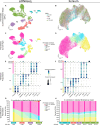This is a preprint.
Mapping mesenchymal diversity in the developing human intestine and organoids
- PMID: 40777494
- PMCID: PMC12330706
- DOI: 10.1101/2025.07.22.665939
Mapping mesenchymal diversity in the developing human intestine and organoids
Abstract
The organization of diverse mesenchymal populations during human intestinal development is critical for tissue architecture and function yet remains poorly defined. To construct a comprehensive, tissue-scale map of the developing human small intestine, we leveraged single-cell RNA-sequencing data to build a custom Xenium spatial transcriptomics gene panel covering the diversity of cell types in the human intestine. Analysis was focused on the developing mesenchyme populations (also referred to as fibroblasts or stroma) given the lack of spatiotemporal information about these cell populations. We defined 5 broad mesenchymal populations occupying discrete anatomical locations within the lamina propria and submucosa - the subepithelial cells (SEC), lamina propria fibroblasts (LPF), submucosal fibroblasts (SMF), smooth muscle cells (SMC), and CXCL13+ fibroblasts. Our data reveal dynamic spatial remodeling of fibroblast communities during development and establish molecular markers to distinguish these populations. We leverage this high-resolution atlas to benchmark pluripotent stem cell-derived human intestinal organoids and to demonstrate how this foundational resource can be used to dissect intestinal stromal signaling in a spatial manner, with broad implications for modeling development, regeneration, and disease.
Keywords: Xenium; development; fibroblast; human; intestine; mesenchyme; single-cell sequencing; spatial transcriptomics.
Figures







References
-
- Elmentaite R., Ross A.D.B., Roberts K., James K.R., Ortmann D., Gomes T., Nayak K., Tuck L., Pritchard S., Bayraktar O.A., et al. (2020). Single-Cell Sequencing of Developing Human Gut Reveals Transcriptional Links to Childhood Crohn’s Disease. Dev Cell 55, 771–783 e775. 10.1016/j.devcel.2020.11.010. - DOI - PMC - PubMed
Publication types
Grants and funding
LinkOut - more resources
Full Text Sources
